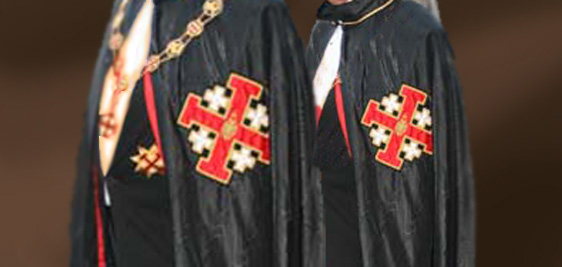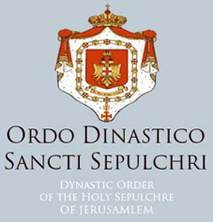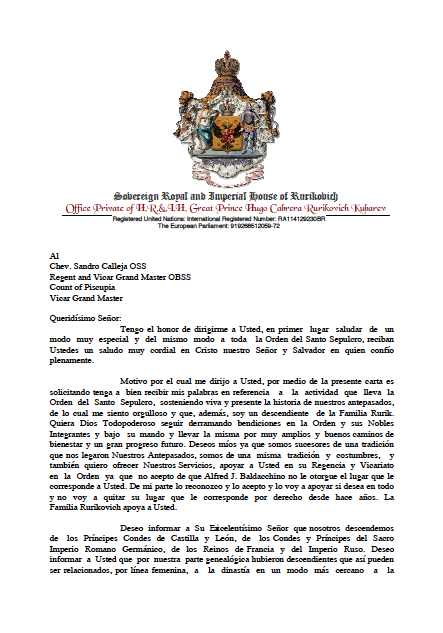

Section III:
Order of the Holy Sepulchre.
ORDO SANCTI SEPULCI (O.S.S.)
In Russia during the Romanoff Dynasty there was The Order of St Andrew, which up to the year 1917 was still in existence. St. Andrew, of course, was held in great veneration in Russia as the first to preach the Holy Gospel, in ancient SCYTHIA, which is the modern Ukraine. The RURICK DYNASTY, founders of the Russian Nation had many Chivalric Orders, which did not belong to the State, but to the Dynasty. The main ones were The Order of FAITH, the Order of the VICTORY, the order of SAINT GEORGE and the most famous the Orthodox Order of the HOLY SEPULCHRE, presently known as the ORDER OF THE HOLY SEPULCHRE. Because of the importance of this Order worldwide, we feel obliged to give it special treatment: Historical and Juridical Profile.
BYZANTINE ORIGIN:
This Glorious Order recalls the eternally valid values of Christian Chivalry and therefore it forms part of the historical heritage of Religious – Chivalric Orders with a particular significant reference to the most ancient and eminent Greek – Orthodox Order of THE HOLY SEPULCHRE. The Order is one of the first, if not the first Order, founded by The Roman Emperor CONSTANTINE THE GREAT son of Saint Helen who discovered the Holy Sepulchre and found the Holy Cross on which Jesus Christ was Crucified and Died.
Considering the influence of Constantine the Great upon the ecclesiastical matters of The Church leaves no doubt that this Order was also recognised by The Church, even before the Orthodoxy.
It traces its reorganisation, however, to the tumultuous period spanning the military and political events of the fall of Constantinople, Capital of the Byzantine Empire in 1453.
These events severed the bonds between Eastern and Western Christendom, and brought to the fore the political vocation of the Russian Grand Dukes who granted assistance and protection to the wandering and dispersed knights of The Holy Sepulchre, including the Orthodox Crusaders who had militated in the Order of Saint Catherine of Mount Sinai since 1063 and who had fought in various Crusades, for the liberation of the Holy Land, and then to The Holy Sepulchres, from the Ottomans.
The marriage in 1472 between ZOE (SOPHIS) PALEOLOGINA, niece of the last Emperor of Byzantium, Constantine XI Paleologo, and IVAN III VELICKY (The Great) Grand Duke of Russia and the Head of the Rjurick Dynasty, brought to the Rjuricks, as the noble bride’s dowry, the Tittle of Pretender to the Throne of Byzantium and encouraged the absorption of many noble Houses and Chivalric Orders which belonged to her Dynasty. From that time onwards the Grand Dukes of Russia adopted the title of ZAR meaning CAESARE.
RJURIK DYNASTY:
The Religious upheaval provoked by the dissolution of the Byzantine Empire, led many dispersed knights to seek refuge in the Patriarcates of Alexandria, Constantnople (ecumenical Patriacate), and Antioch. Meanwhile, Dimitrij VII Dimitrevic, Grand Duke in exile of the Imperial Rjurick House of Russia and direct descendant of IVAN and ZOE Paleogina, had established Himself in Enos in the OTTOMAN EMPIRE, around 1660, where many dispersed knights gathered around Him seeking Protection and Guidance. The Grand Duke organised and led them with great prudence and wisdom, earning their gratitude and devotion until they proclaimed him Grand Master of the Order. This resulted in formin a fusion between the survivors of the Greek Orthodox Order of the Holy Sepulchre and those of the Order of St. Catherine of Mount Sinai.
RECOGNITIONS:
In 1669 Sultan Mohammed IV Osman granted Dimitrij VII Dimitrevic recognition of his prerogatives and membership of the House of Moscow as Head of the Name and Arms of the Rjurick Dynasty. The Sultan accorded Him the title of Bay of Enos and granted hospitality and protection to Him, as Head of the House of Moscow and to His Orders and Cultural Institutions.
Dimitrij VII Dimitrevic incorporated the Order in His House and rendered the Order Dynastic, revising the Statute and rendering the Grand Mastership hereditary in his family. In 1671, the Order was recognized by an Edict of ROI SOLEIL. Meanwhile the Order Consolidated and flourished in various countries in the East and West.
In 1788 Duke Ercole III authorized the establishment of the Order in the Duchy of Modena, granting the Citizenship of the Duchy of Modena to the Head of the Imperial House of Moscow and De Jure recognition to His Orders and Cultural Institutions.
On that occasion the Order was confirmed under the Rule of Saint Basil and assumed as one of its principal aims that of assisting Christian pilgrims visitng the Holy Places, recalling the ecumenical spirit of the “EDICT OF MILAN” with which Constantine the Great had decreed the freedom of worship be guaranteed to the faithful of all religions, prncipally the Christians.
The Order was reorganised 1821, in 1943, in 1965 and in 1976.
On the officially recognized Coat of Arms of the Grand Duke is incorporated the Grand Collar of the Order of Saint Andrew belonging to the Romanoffs. This proves that even the Romanoffs House recognised the Grand Dukes of Moscow in all their Rights.
THE HEREDITARY GRAND MASTERS OF THE ORDER SINCE 1669
1669 – 1688 DIMITRIJ VII DIMITREVIC
1688 – 1730 MICHAJL III DIMITREVIC
1730 – 1757 VASILIJ IV MICHAJLOVIC
1757 – 1787 VASILIJ V VASILJEVIC
1787 – 1821 DIMITRIJ VIII VASILJEVIC
1821 – 1861 MICHAJL IV DIMITREVIC
1861 – 1913 VASILIJ VI MICHAJLOVIC
1913 – 1965 DIMITRIJI IX VASILJEVIC
1965 – 2001 DIMITRIJ X DIMITREVIC
Read More...
SECTION IV: Independent Orders


